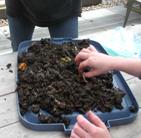 After about 2 to 3 months there should be a few inches of worm castings ready for harvesting. The brown, earthy-looking material at the bottom of your bin is finished compost that your worms have made for you. As you remove the finished compost you will need to remove any worms that are remaining. It can be difficult to get them all so don’t worry if you miss a few.
After about 2 to 3 months there should be a few inches of worm castings ready for harvesting. The brown, earthy-looking material at the bottom of your bin is finished compost that your worms have made for you. As you remove the finished compost you will need to remove any worms that are remaining. It can be difficult to get them all so don’t worry if you miss a few.
You should also keep an eye out for worm eggs. Eggs are lemon shaped, white to brown in colour, and slightly larger than the head of a pin. If you spot any eggs simply put them back in your bin. Again don’t worry if you miss some, your worms will keep reproducing. There are several methods of harvesting finished compost from your bin:
The Food Migration Method
Move all of your bin contents to one side and add a fresh layer of bedding to the vacant side. Place food under the new bedding and wait a few weeks for your worms to migrate to the fresh food. This method should leave the finished compost almost free of worms. If you add melon scraps (Red Wrigglers’ favourite food) they will migrate even quicker to the vacant side of the bin. Once you have harvested your finished compost, you can fill the bin with some fresh bedding and start again.
The Light Method
Open your bin, remove any loose bedding from the top, and place it under a light. As Red Wigglers prefer the dark, they will burrow down away from the light. As the worms move down you can scrape away finished compost from the top layer. Once you reach worms, just stop for approximately 10 minutes while they move even further down and then remove another layer. You can repeat this process until you cannot remove any more of the finished compost. Once you have harvested your finished compost, add some fresh bedding and start over again.
Harvesting with a stackable tray system
 If you have a stackable tray system or “work tower”, simply add a new tray with fresh bedding and food and your worms will migrate upward to that tray. You can continue adding trays until you run out and at that point the bottom tray(s) should be worm free. You can simply harvest your compost and then start again adding the removed trays to the top. Your tray system For more information, check instructions that come with your bin.
If you have a stackable tray system or “work tower”, simply add a new tray with fresh bedding and food and your worms will migrate upward to that tray. You can continue adding trays until you run out and at that point the bottom tray(s) should be worm free. You can simply harvest your compost and then start again adding the removed trays to the top. Your tray system For more information, check instructions that come with your bin.
How to use your finished Vermicompost
Finished vermicompost can be used in many different ways. It can be used both outdoors and indoors as a natural fertilizer for gardens, shrubs, or plants. Vermicompost is however much richer than outdoor compost and so a little can go a long way.
Vermicompost is especially good for making a rich liquid fertilizer called compost tea which can not only provide nutrients for your plants or garden, it can also suppress leaf disease when sprayed directly on the plant leafs.
Questions
- Give us a call: toll free at 1-866-394-8880 or in Winnipeg at 204-925-3777
- Drop us an email at compost@greenactioncentre.ca].
- Check out our composting FAQ page.




Recent Comments